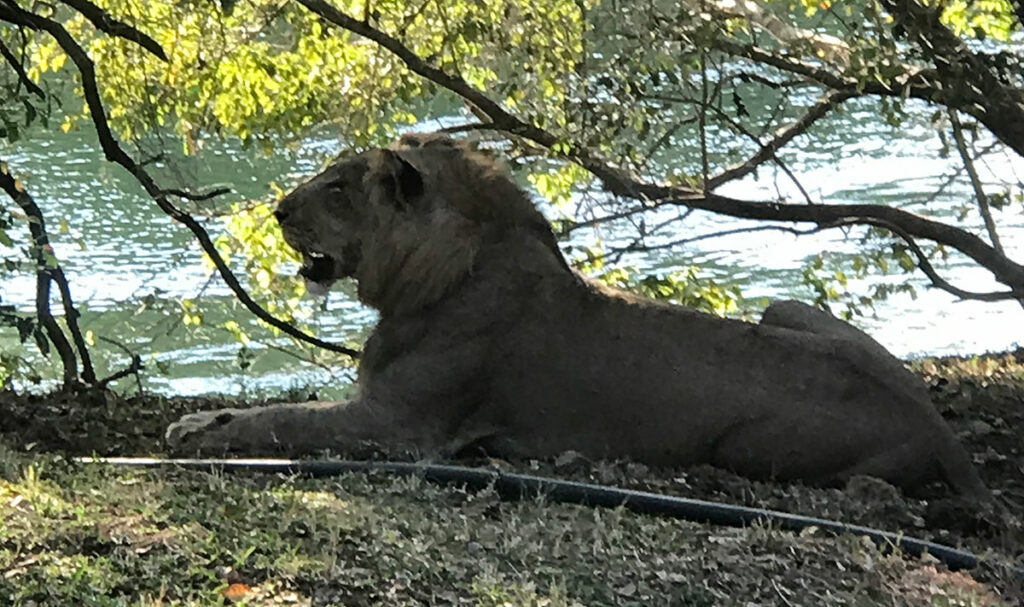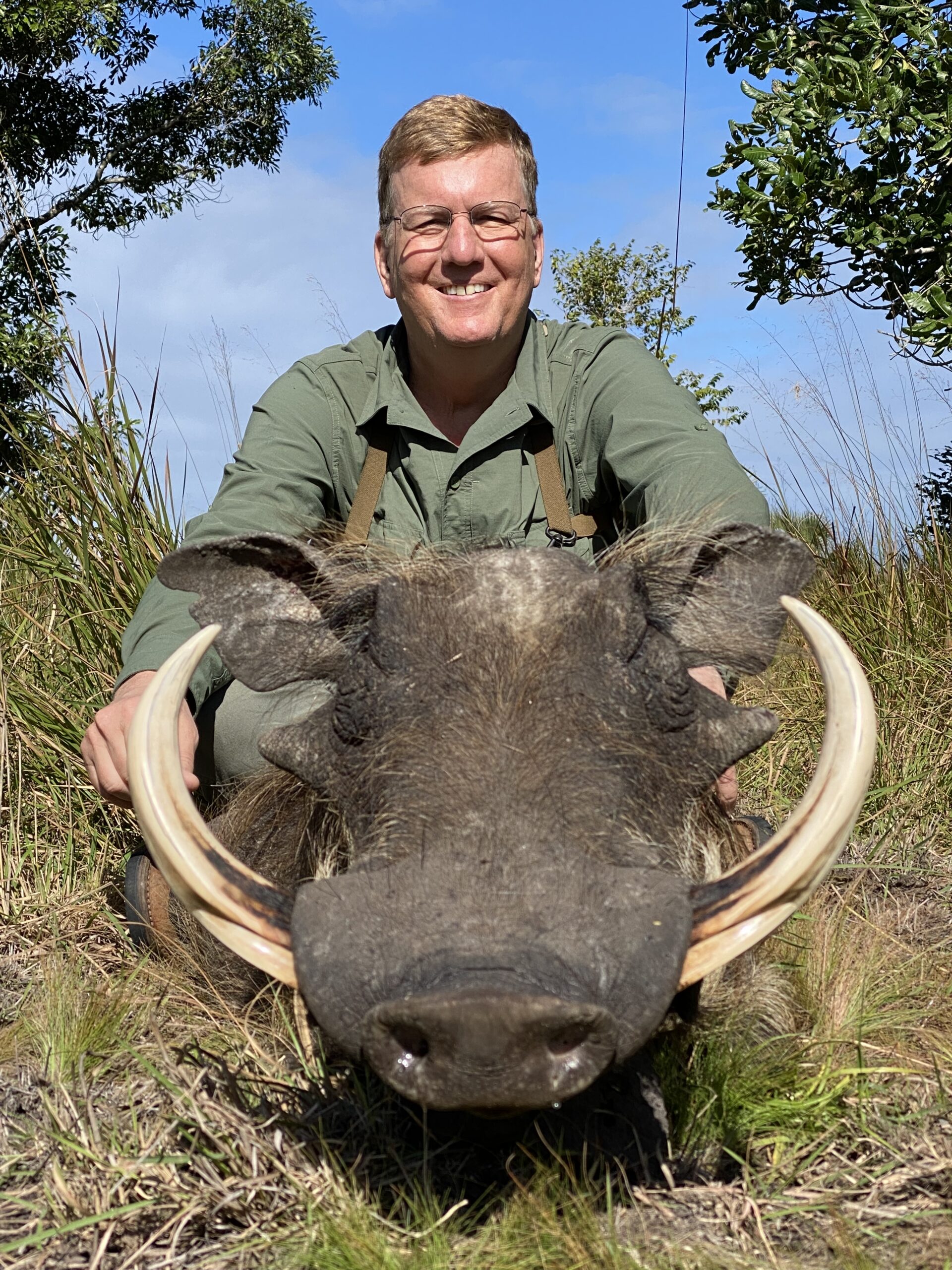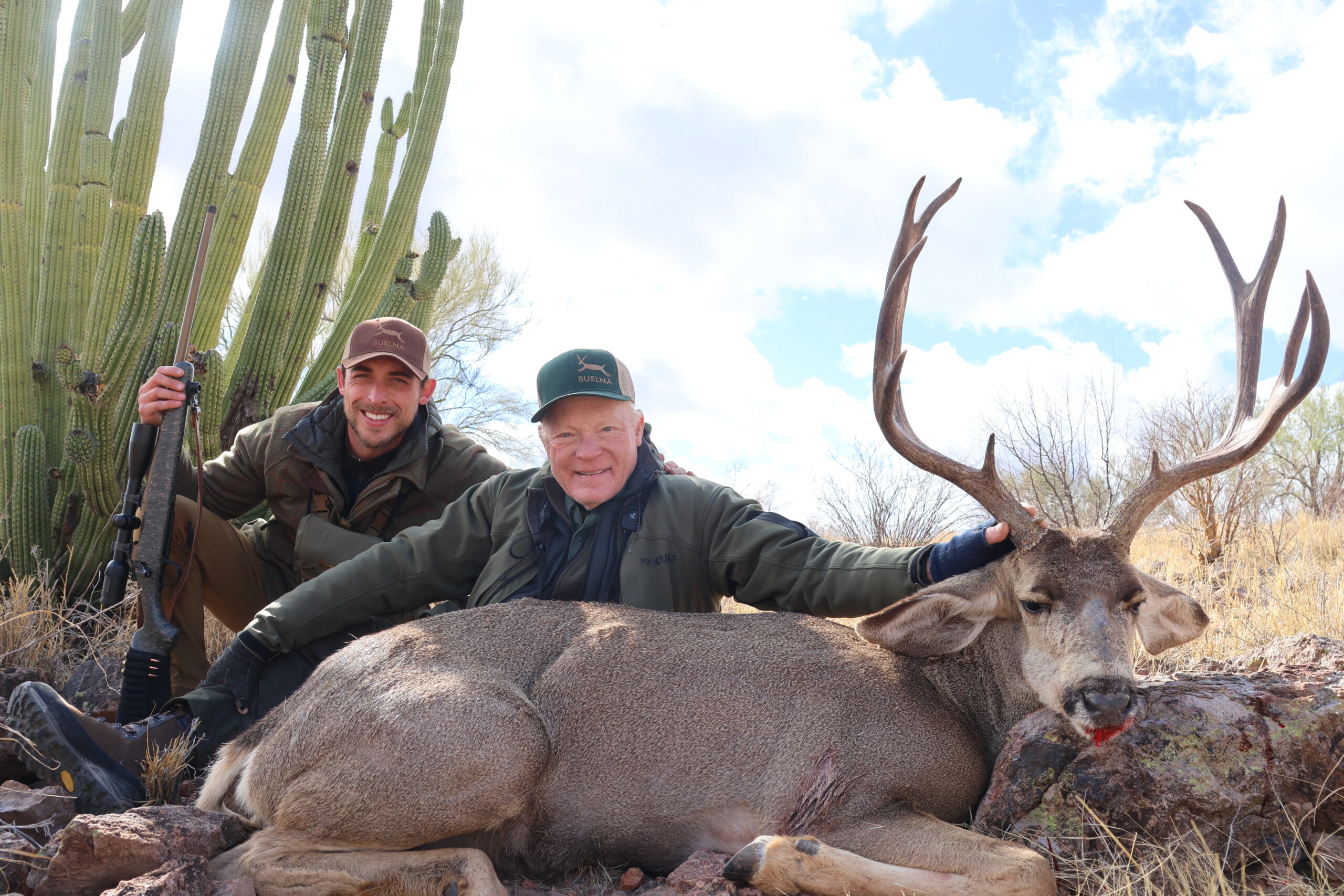The vehicle dropped us off next to our grass ground blind around 6 a.m. Only minutes after the vehicle left, the massive male lion emerged from the thick bush about 50 yards from our blind.
Instead of stopping to feast on the hippo bait we had hung in a tree, he walked right past it, stopped, stared curiously at the blind, then headed directly toward us. At 23 yards my PH, Mark Swanepoel, whispered, “If he takes another step shoot him!”
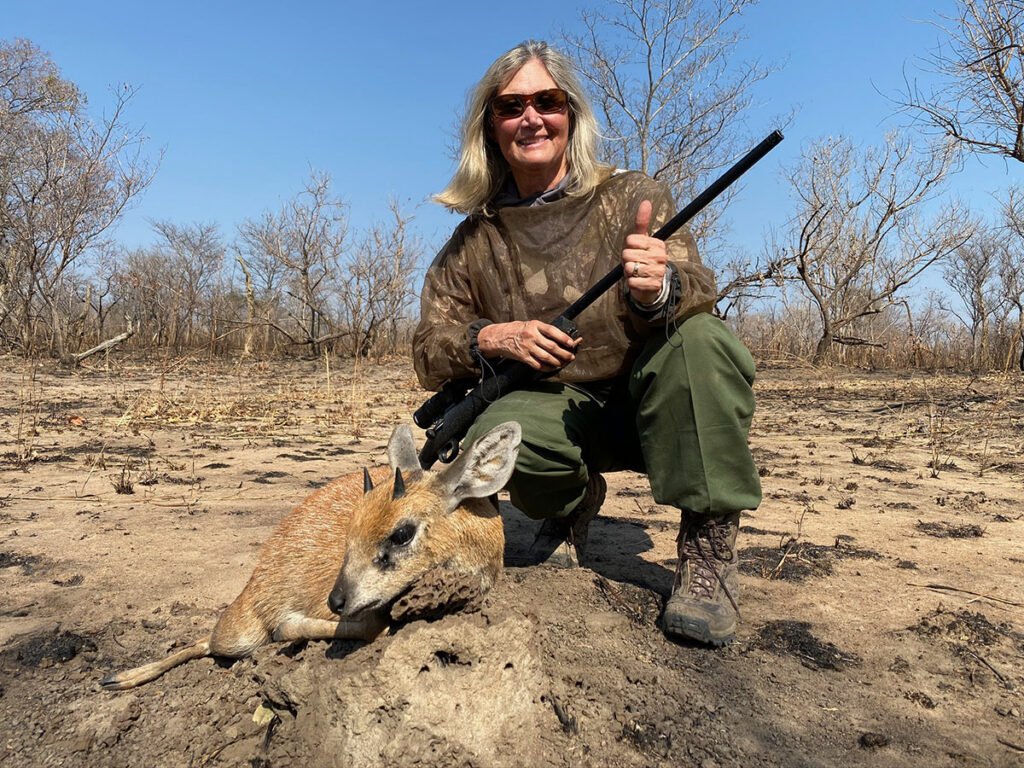
The year 2020 began with exciting hunting plans for my husband and me. However, I shattered my right dominant wrist in early January, then in June had retina surgery on my dominant left shooting eye. That and COVID caused us to postpone hunts to Mexico, Uganda, South Africa, Italy, Newfoundland, the Yukon, Spain, Turkey and Tajikistan.
We still hoped that we might make it to Zambia on our dangerous game hunt if it reopened to international travelers. It did in July, allowing us to self-quarantine in the bush instead of in a hotel.
I’ll confess that with my shattered wrist and blurry left eye, I had serious doubts about my ability to shoot anything. Especially dangerous game.
The solution was Bog Death Grip shooting sticks. I could place my rifle in clamps, then tighten it in. It had good up-and-down and left-and-right motion. They are heavy and I could hold one of the legs to steady myself. They weren’t great for getting off a quick shot, but they were a great platform for my broken wrist.
After many delays and COVID bureaucratic roadblocks, we were finally able to get our visas the day before we planned to. With the visas, firearm permits, negative COVID tests, passport photos and a travel clearance letter from the Minister of Health in hand, we were on our way!
Just a heads up. You must apply online for an E-Visa. Make sure you have everything they request before you start applying and uploading. It took me seven tries before I succeeded.
The only airline flying to Lusaka, Zambia is Ethiopian Airlines via Dulles International, connecting through Addis Ababa. Be sure you allow at least three hours to check-in with firearms at Dulles. Apparently, we were the first American hunters to arrive in Zambia and the guinea pigs in this new world of international Covid-19 travel.
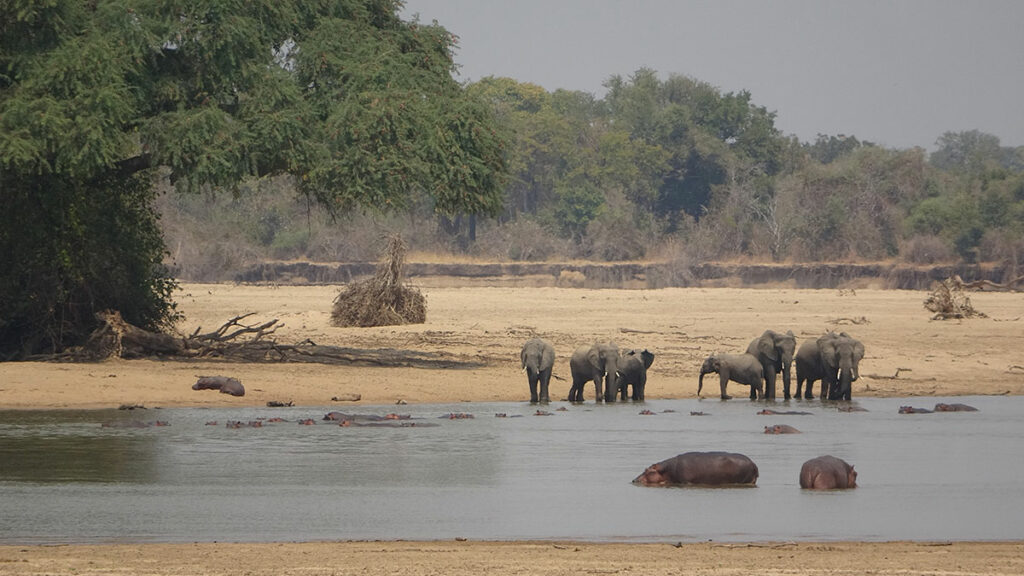
Our overnight flight from Dulles International was on time and the service was excellent. Thandi Swanepoel, Safaris’ assistant, met us at the Lusaka Airport. She expeditiously helped us clear customs with our firearms. We spent the night at the Protea Marriott Hotel and had a great dinner at their Steakhouse Restaurant.
Social distancing, masks, sanitizing stations, temperature checks and contact tracing forms were everywhere. Just as we arrived the government mandated that everyone had to wear masks while in their cars, even if they were alone, or risk getting a $30 fine. We felt safer in Zambia than we did in our local supermarket!
The next morning, we headed for the bush to Swanepoel’s Safari’s Mumbwa West GMA concession located along the Kafue River adjacent to the Kafue National Park.
Lion and a big elephant were my primary objectives, but I also hoped for Sharpe’s grysbuck and Cookson’s wildebeest, which were not among the 60 species I have already taken while hunting in five continents around the world.
I have taken leopard, hippo, buffalo and crocodile in previous safaris in Mozambique and Zambia. However, I am always open to improving on my trophy quality.
I only started hunting 10 years ago at the age of 62 after spending 20 years living in Monaco, where I enjoyed the opera, ballet and symphony. There is not much hunting there, at least not of the animal variety.
My husband Jon, who is an accomplished bowhunter, has hunted all over the world. When we met, he told me that he didn’t care if I didn’t hunt but that I couldn’t be an anti-hunter.
I have developed a passion for hunting, not only because of the thrill of being successful, but even more importantly I have gained a deep understanding of the conservation benefits and the other positive impacts that ethical hunting has around the world. Hunting is conservation! It protects habitats, provides jobs, stops poaching and saves wildlife from encroachment.
The lion was still walking toward our blind. It was obvious that he was not going to give me the preferred broadside shot.
Mark whispered, “Just hold right under his chin and shoot! Now!” I hit him perfectly in the chest under his chin with my Rifles, Inc .375 H&H using Barnes 270-grain Vortex bullets.
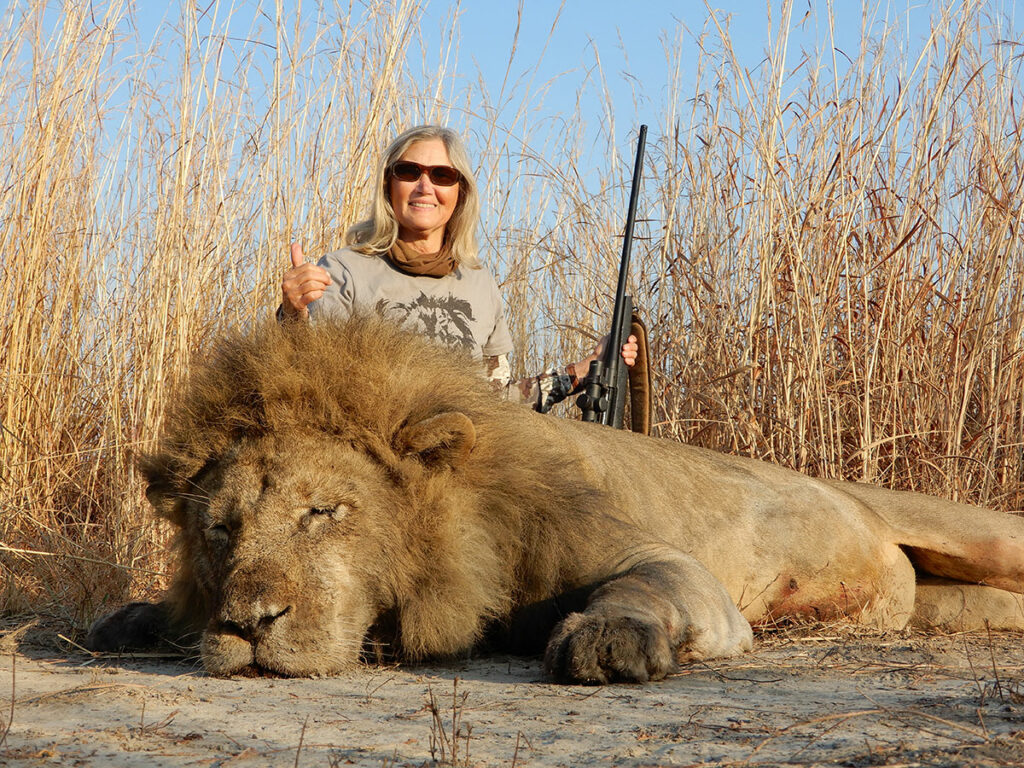
With a stunned look and a terrifying roar, he headed toward the tall grass to my right. Before I could get off a second shot, he was out of sight. We waited about half an hour before beginning to track him.
Let me tell you, following his blood trail was truly nerve-racking. My heart was pounding! Thankfully, he didn’t go far, and we spotted him dead in an opening in the tall grass. After reviewing the video footage, the lion dropped his head just as I shot and the bullet went slightly to the right, but it was a fatal shot.
He was a huge old lion with badly worn down and broken-off teeth, estimated to be 12-14 years old. It is difficult to judge the age of lions over seven years old, but in twenty years of owning this concession, he was the oldest lion the Swanepoels had ever seen.
Obviously, he had been kicked out of his pride by a younger, tougher male and was now forced to hunt on his own. Since female lions normally do most of the hunting, he would struggle to survive and likely would have had only a year or two to live at the most.
When we entered camp the trackers on our vehicle and the camp staff were celebrating by singing the traditional African Chipolo-polo song. I felt deeply honored and felt the joy in their song. Native villagers have a deep fear of lions, especially old male lions, which often kill their livestock and on occasion turn into man-eaters.
After skinning him, an Official SCI Master Measurer measured his skull, the preliminary score was 27 4/16,” which would make him the #1 lion ever shot by a woman and tied for #8 overall (the current woman’s #1 scores 26 8/16”). He will be measured again after the mandatory 90-day waiting period to see if his ranking holds up. Nonetheless, he is a magnificent trophy and will stand in our trophy room next to a huge lion my husband shot with his bow in Zambia a number of years ago.
A monster crocodile was our next adventure. In 2018 while in Mumbwa, I had wanted to shoot a croc named “Big Mike,” who was reported to be 13 feet long. I tried several times, but he never gave me a shot.
Thanks to my husband for shooting a bobbing hippo early the first morning of the hunt, we had plenty of bait for cats and crocs. The trackers staked some hippo meat to the bank downstream from camp, hoping to lure in a huge croc. We had seen a large green-and-yellow croc the day before, so a blind was built about 100 yards from that bank. In order to get to the blind unseen, I would have to cross a small side channel of the river. I had sworn I would never walk in croc infested waters in Africa!
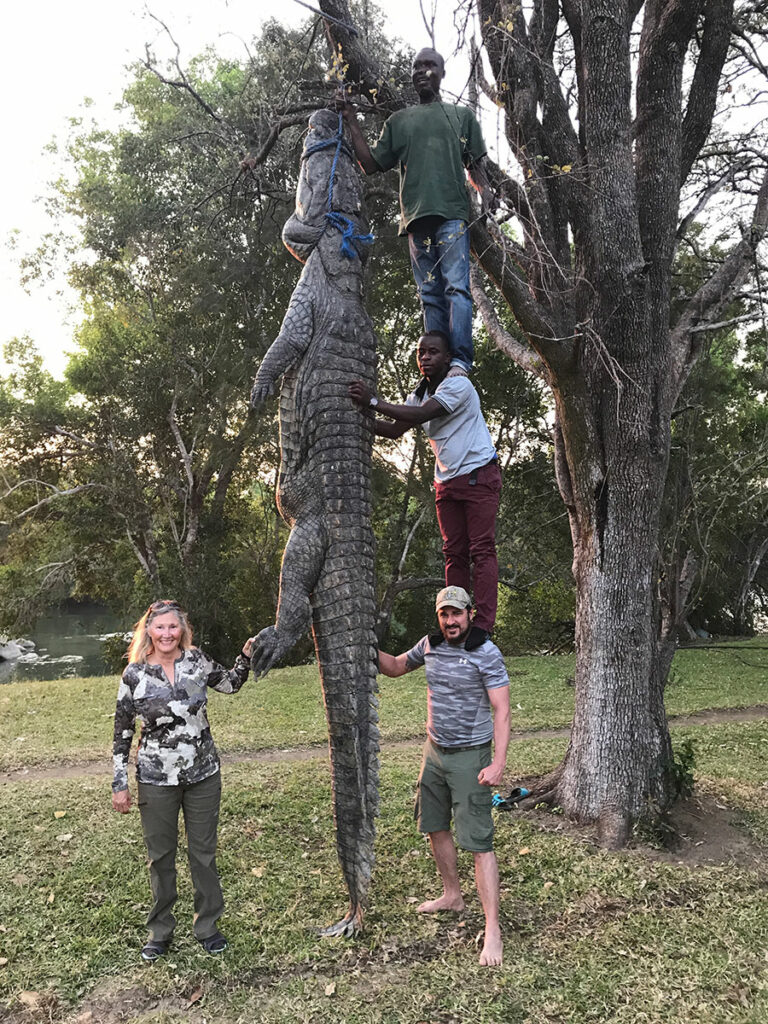
Sitting in camp the next afternoon I spotted what at first appeared to be a large rock on the same bank about 450 yards downstream from our camp on the Kafue River. Shortly thereafter, a member of the camp staff came running into the camp and told my PH that there was a crocodile sunning himself on the bank downstream.
I told Mark what I had seen. He picked up his binoculars and said, “Omigod, that’s an enormous croc, let’s go!” The croc was about 70 yards away from the blind and laying broadside. I crept silently into the blind, put my crosshairs on his neck and hit him perfectly in the spine. As he rolled over, both the PH and I put anchoring shots into him and he never moved again.
Getting him into the banana boat and back upstream to camp was a struggle. When they got him to the riverbank in camp, they needed to winch him up to the flat area. Eight men couldn’t lift him. He was 14 feet long and estimated to weigh over 1,000 pounds and thought to be 60 to 70 years old.
While the lion and croc were the highlights of our trip, my adventures were not over. We flew to Mfuwe on a domestic flight, then drove five hours to the Mutinondo area to start my 12-day, first-ever elephant hunt.
This area is in the Luangwa Valley and part of the Nyampala GMA. On our first day, as luck would have it, we saw a shootable 40 to 45-pound elephant, but since it was the first day we passed, hoping for a larger one.
On the second day we saw another one but he had one fat tusk and one skinny one, so I passed again. This area is reputed to have big bulls who migrate there, especially in October, where the temperature can be 110 degrees in the shade.
The local villagers were a big help, always telling us that they saw big elephants eating their crops either last night or in the early morning before we arrived. Of course, each village wanted the elephant meat, which could feed a hundred villagers for several months.
Elephants have a serious impact on corn and other crops that the villagers raise to feed their families. The Frankfurt Zoological Society and the Nabwalya community have developed and built low cost elephant-proof grain storage containers (EPGS) made out of cement, which defeats the elephants’ keen sense of smell and saves their crops.
I was so impressed that I donated money to build five of them in those remote villages, which were so helpful. After six days, cooler weather and overcast skies and seeing no elephants, we moved to the main Nyampala camp. Here we tracked many elephants over the next five days, but never saw a bull big enough to shoot. My only regret is that I did not shoot an elephant. It could have provided those villagers with much appreciated and needed meat.
In between the lion and elephant hunts, I did manage to shoot a Sharpe’s grysbuck, a much sought-after trophy, but very difficult to hunt, and the native Cookson’s wildebeest.
Along the way we saw a pack of eight wild dogs, a sleeping cheetah and its kill 800 yards away, a jewel beetle and a chameleon, which is considered a bad omen. One landed on the shirt of our game scout!

We also saw baby hartebeests, sables and a one-week-old hippo. Most surprising was a daytime visit by a three-year-old male lion standing 30 feet from our cabin.
My exciting hunts, seeing the variety of Zambian wildlife, its habitat, seeing all the smiling village children and overcoming Covid-19 issues made my third trip to Zambia a truly memorable experience.
If a woman in her 70s with a broken wrist, who only started hunting 10 years ago, can achieve what I have with the enjoyment of doing it together with her husband, then I hope to inspire other women. It is never too late to learn to hunt!–Siri Campbell Fossel

